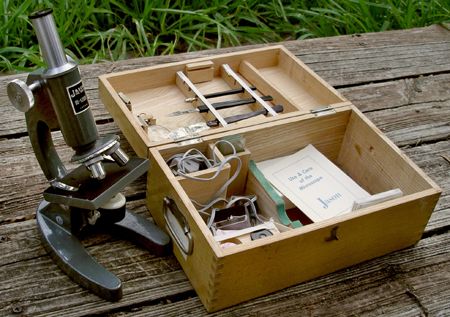
In the summer of 1961, my parents took me on our first family camping trip. The destination was Florida. One of the main reasons for this adventurous excursion was my fascination with sea shells and other ocean creatures. As a 3-year-old in Illinois, I had never experienced the ocean, but I'd obviously heard about it and seen pictures, so I was keen to go there. Luckily, travel and camping were not particularly expensive back in those days, so our modest income was sufficient to allow for the trip.
Seeing salt water creatures up close made me even more enamored of the biological sciences, and I must have continued to pester my mother about all manner of animals, from the biggest to the tiniest. That autumn, in October, my mother spent $40.25 on an item simply listed as "microscope" under the "recreation" column of her expenses ledger. This little bit of history would probably have been lost but for my mom's perpetual record-keeping, including data sheets of income and expenses, especially during the early years of my parents' marriage. I wonder how many couples back then would have made such a lavish expenditure when their total annual income was under $7000. When I recently asked about the purchase of the microscope, my mother remembered that it was bought at Service Merchandise, where her cousin worked and would tell her about any specials they had.
The microscope was made in Japan by a company called Jason. It was heavy - made mostly of metal, with smoothly functioning gears for focusing. There were various primary and secondary lenses, so that the magnification ranged from 80x to 1200x. This was no child's toy, but a very functional tool.
My first actual memory of using the microscope was during our next summer's camping trip, which was to Cape Hatteras and south into Florida again. I was four years old and so remember only isolated snippets from that vacation. We had a big canvas tent and, after enduring some heavy rains, my parents deemed it prudent to spend a night in a motel so they could try to dry everything out. We had just visited Venice, FL, where we collected fossil shark teeth on the beach. In our motel room, the microscope was set up on a desk or counter and I placed one of the fossils on the platform, hoping to see it in more detail. I distinctly remember being surprised and disappointed that it was just completely black. I suspect that my mother had always set up the slide with algae or microbes on it before this, so my first solo experiment included the practical lesson of choosing an appropriate subject for viewing.
In the years that followed, my sister and I used the microscope to examine everything from hairs to protozoa from local ponds. Besides flat glass slides, we also had slides with a shallow indentation. This allowed the microbes to swim about as if in a miniature aquarium. Seeing the individual cells in algae or the moving cilia of a paramecium was so captivating that I often spent too long looking in the little eyepiece and then my eyes had to readjust once I returned to the "big" world. It was absolutely thrilling to see the long stem of a vorticella coil like a spring and pull the tulip-shaped body away from a swimming euglena that happened to touch the fringe of cilia around the top. I saw the eggs inside a daphnia and watched as cyclops scooted around their tiny water drop world. Amoebas resembled spilled liquid that could move on its own. Seeing the creatures themselves, like glass sculptures that could propel themselves about, was far more engaging than simply looking at pictures in a book.
As we got older, we were allowed to use the microscope without adult supervision. I certainly broke my share of the thin cover slides, and occasionally forgot to focus from close to distant, but instead did the reverse, a maneuver which usually resulted in the classic "crushed specimen under cracked glass." In spite of the difficulties, it was wonderful to be able to see a planarian's eyes or the little claws on the ends of insect legs.
I no longer spend much time looking into a microscope. My interest has gravitated to animals slightly bigger and I now mainly use a digital camera to extend my vision beyond its physical limits. But I might never have developed the urge to see that which is usually hidden from view if it hadn't been for my mother's decision to spend a portion of our family's hard-earned budget on a basic scientific tool to help teach us about the world we live in. Her insightful decision about what was important at the time helped us to satisfy our curiosity while allowing us to delve beneath the obvious in our quest to understand even the tiniest forms of life around us.